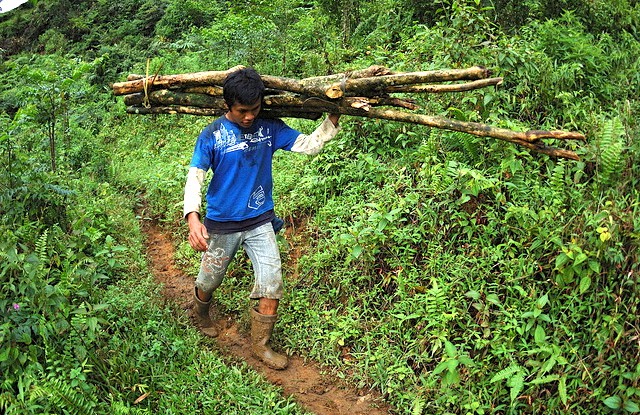It is clear that REDD+ has changed from what was first envisaged. First formulated in 2005 as part of the United Nations Framework Convention on Climate Change, the approach attracted high hopes for slowing down climate change by reducing emissions from deforestation and degradation. An integral part of the approach that was originally conceived included direct payments to forest users for not deforesting or degrading forests.
This has not turned out to have been as central to REDD+ implementation as initially expected. There is still, however, broad consensus that the global beneficiaries of climate change mitigation should provide benefits greater than the burdens faced by local forest users who are asked to conserve forest.
A new paper by scientist Dr. Amy Ickowitz of the Center for International Forestry Research (CIFOR) and colleagues Erin Sills and Claudio de Sassi shows just how much smallholder farmers in a variety of REDD+ sites would actually lose if they were to stop all deforesting and degrading activities, and were not compensated. The paper also outlines how these costs vary between the richest and poorest farmers.
ON THE CHEAP?
Using data from CIFOR’s Global Comparative Study on REDD+ (GCS REDD+), taken from a number of sites across six tropical countries, the new paper shows that initial estimates of how much smallholder farmers should be compensated for their losses from foregoing deforesting and degrading activities were underestimated.
That led to a mindset in which policymakers and donors thought they could reduce emissions “very cheaply,” according to Ickowitz.
In some cases, this is true. But in many others, it is not. This mindset does not adequately take into account the fact that costs vary widely, even within the same community.
The study separated costs by income group to show how the opportunity costs of deforestation and degradation differ between the richest and poorest members of the communities. As it turns out, these differences can be very large indeed.
Making payments based on more accurate opportunity cost estimates would make REDD+ programs more equitable and likely more effective, says Ickowitz.
She adds that the research shows how a system of flat payments — per hectare, or per household — could be a “pro-poor” approach, as lower-income households have lower average opportunity costs compared to richer farmers in all study sites considered across all six countries.
DEFINING OPPORTUNITY COSTS
So what exactly is an ‘opportunity cost’?
Simply put, it is the income a forest-user loses after complying with REDD+ restrictions on his or her land. If a farmer used to clear trees and grow crops on that land, the opportunity cost is the value of the production he or she has had to give up.
Based on household data and estimates of carbon stocks from six tropical countries, Ickowitz and her team found that opportunity costs per ton of carbon for most of the smallholders in the study exceed current market prices on the voluntary carbon market.
In the early days of REDD+ thinking, estimates of smallholder opportunity cost were much lower than they turned out to be. At the same time, carbon market prices did not rise to the level that many had anticipated.
One of our main findings is that despite many concerns that REDD+ would mostly hurt poor farmers, if payments were made to farmers based on average community opportunity costs, they would most benefit the poorer farmers in our sample.
But even if carbon prices were to rise to a level that would be able to fully cover average opportunity costs of forest users, there would still be distributional considerations.
A flat payment system could increase transparency, reduce transactions costs, and benefit the lowest income households. But under this type of system, forest-users with higher incomes would not be fully compensated unless payments were set at higher-than-average costs – thus they would either opt out, or lose out from participating in REDD+.
If compensation costs were set at higher-than-average rates to attract the higher income households, costs would substantially increase.
GLOBAL BENEFITS
On the other hand, the opportunity costs to smallholders in all but one of the sites sampled were less than the social cost of carbon as estimated by an Interagency Working Group of the U.S. federal government.
Therefore, reducing deforestation by smallholders and consequent carbon emissions “would generate net global benefits,” Ickowitz and her colleagues conclude.
But the research also makes clear just how serious an economic loss REDD+ restrictions can impose on small farmers if they are not compensated adequately.
“This, to me, is the real significance of having real numbers from real people across many different places,” says Ickowitz.
And because it is so hard to conduct detailed household surveys at all locations where REDD+ will be implemented, the wide range of sites sampled across the tropics increases the value of the data.
While REDD+ may have evolved into a different type of mechanism than originally conceived, ultimately, it is still about getting forest users to change their behavior.
The research brings us back to looking at what is required to compensate smallholder forest users fairly if they are asked to change their activities. Without equitable compensation, forest-users are not likely to cooperate. This means getting compensation right may well be one of the many issues REDD+ needs to overcome to fulfill its objectives at meaningful scale.
We want you to share Forests News content, which is licensed under Creative Commons Attribution-NonCommercial-ShareAlike 4.0 International (CC BY-NC-SA 4.0). This means you are free to redistribute our material for non-commercial purposes. All we ask is that you give Forests News appropriate credit and link to the original Forests News content, indicate if changes were made, and distribute your contributions under the same Creative Commons license. You must notify Forests News if you repost, reprint or reuse our materials by contacting forestsnews@cifor-icraf.org.
